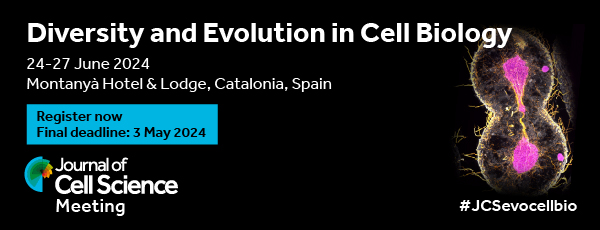Issues
-
Cover image
Cover Image

Cover: Micropatterned single neonatal rat ventricular myocyte. Constrained cell geometry results in distinct distribution of focal adhesions (red) and the actin cytoskeleton (green). Spatially non-uniform distribution of focal adhesions leads to differential regulation of ion channel localization in membrane of excitable cells. See article by S. Sengupta et al. (jcs225383).
- PDF Icon PDF LinkTable of contents
- PDF Icon PDF LinkIssue info
RESEARCH HIGHLIGHTS
STICKY WICKET
FIRST PERSON
CELL SCIENTISTS TO WATCH
MEETING REPORT
REVIEWS
Ubiquitin-based modifications in endothelial cell–cell contact and inflammation
Summary: Endothelial cell–cell contacts protect tissues from edema and uncontrolled invasion of inflammatory cells. Here, we discuss the emerging role of ubiquitylation of specific proteins controlling endothelial integrity and inflammation.
How the mechanobiome drives cell behavior, viewed through the lens of control theory
Summary: Cells use sophisticated control systems to drive cell behaviors. The mechanobiome senses inputs, establishes and maintains system setpoint and integrates different cellular processes with mechanics to ensure robustness against disturbances.
RESEARCH ARTICLES
The S. pombe adaptor protein Bbc1 regulates localization of Wsp1 and Vrp1 during endocytic actin patch assembly
Highlighted Article: The endocytic adaptor protein Bbc1 regulates endocytosis in fission yeast via its association with the myosin-I tail, thereby limiting association of the yeast WASp with myosin-1 at the base of endocytic invaginations.
Circulating tumor cells exit circulation while maintaining multicellularity, augmenting metastatic potential
Highlighted Article: Circulating tumor cell clusters spread throughout the body by using a unique method to exit blood vessels, which grants the tumor cells an increased ability to form secondary tumors.
Monoallelic, antisense and total RNA transcription in an in vitro neural differentiation system based on F1 hybrid mice
Summary: A quantification of the dynamics of monoallelic, antisense and poly(A)− expression, distinction between poly(A)+ and poly(A)− antisense transcripts, and bimorphic transcription during neural differentiation.
DCAF8, a novel MuRF1 interaction partner, promotes muscle atrophy
Highlighted Article: DCAF8 is a novel MuRF1 interaction partner that promotes muscle atrophy and thereby links CRL4 ubiquitin ligase complexes to the loss of muscle mass.
The golgin PpImh1 mediates reversible cisternal stacking in the Golgi of the budding yeast Pichia pastoris
Summary: In light of cisternal maturation, Golgi stacking needs to be reversible. The evolutionarily conserved GRIP domain golgin PpImh1 is implicated in such reversible cisternal stacking, suggesting a novel, but conserved mechanism.
PPE39 of the Mycobacterium tuberculosis strain Beijing/K induces Th1-cell polarization through dendritic cell maturation
Summary: The Mtb Beijing/K-specific protein PPE39 induces maturation of dendritic cells via TLR4, promoting polarization of naïve CD4+ T cells towards the Th1-cell phenotype.
Ahi1 promotes Arl13b ciliary recruitment, regulates Arl13b stability and is required for normal cell migration
Summary: The Joubert syndrome-causing protein, Ahi1, acts as a gatekeeper in regulating primary cilia protein composition and length. Ahi1 also regulates Arl13b stability, Shh signaling and cell migration.
An acute decrease in plasma membrane tension induces macropinocytosis via PLD2 activation
Highlighted Article: A mechanical induction pathway of macropinocytosis is elicited by acute decrease of plasma membrane tension and followed by lipid/PLD2 nanodomain disintegration, PLD2 activation and PA production.
The cytoplasmic C-terminal region of the ATP11C variant determines its localization at the polarized plasma membrane
Summary: ATP11C-b, a C-terminal splice variant of the PS-flippase ATP11C, localizes to a limited region of the plasma membrane in polarized cells, and LLXY residues are critical for the localization.
Altering integrin engagement regulates membrane localization of Kir2.1 channels
Summary: Intracellular and extracellular signals affecting focal adhesions regulate the membrane localization of Kir2.1 channels to profoundly influence electrophysiology of excitable cells, including cardiomyocytes.
Sirtuin 7 promotes 45S pre-rRNA cleavage at site 2 and determines the processing pathway
Summary: In humans, sirtuin 7 plays a key role in the synthesis of ribosomal subunits by controlling critical endonucleolytic cleavages of precursor ribosomal RNAs.
CORRECTION
Introducing our new Editors

We welcome three new Editors to Journal of Cell Science - Robert Parton, Richa Rikhy and Simon Cook. You can read more about them in the Editorial from our Editor-in-Chief Michael Way.
2024 Journal Meeting 'Diversity and Evolution in Cell Biology'

Registration is open for our 2024 Journal Meeting Diversity and Evolution in Cell Biology, which aims to bring together evolutionary biologists and cell biologists investigating diverse aspects of cellular physiology. Final registration deadline: 3 May 2024.
Workshop: Physics of the Early Embryonic Cell Divisions

Early-career researchers interested in the roles of nuclear lipids, apply now for one of the ten funded places at this Workshop, which will take place 11-14 November 2024. Application deadline: 17 May.
Reasons to submit to Journal of Cell Science

There are many benefits to publishing in Journal of Cell Science - read more about why you should choose JCS or visit our submission page now.
Propose a new Workshop for 2026

We are now accepting proposals for our 2026 Workshops programme. We aim to be responsive to the community and open to novel initiatives, so if you have a new idea for a biological workshop that you feel would work well, please apply. Applications deadline: 19 July 2024.



